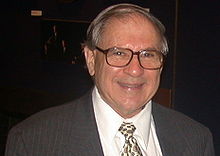Bernard Galler
Bernard Galler | |
|---|---|
 Bernard A. Galler (2004) | |
| Born | October 3, 1928 Chicago, Illinois, U.S. |
| Died | September 4, 2006 (aged 77) Ann Arbor, Michigan, U.S. |
| Education | University of Chicago (BS, PhD) University of California, Los Angeles (MS) |
| Scientific career | |
| Institutions | University of Michigan |
| Doctoral advisor | Paul Halmos Marshall Stone |
Bernard A. Galler (October 3, 1928 – September 4, 2006) was an American mathematician and computer scientist at the University of Michigan who was involved in the development of large-scale operating systems and computer languages including the MAD programming language and the Michigan Terminal System operating system.[1][2][3]
Education and career[edit]
Galler attended the University of Chicago where he earned a BSc in mathematics at the University of Chicago (1947), followed by a MSc from UCLA and a PhD from the University of Chicago (1955), advised by Paul Halmos and Marshall Stone. He joined the mathematics department at the University of Michigan (1955) where he taught the first programming course (1956) using an IBM 704. Galler helped to develop the computer language called the Michigan Algorithm Decoder (1959-) in use at several universities. He formed the Communication Sciences dept (1965), renamed Computer Sciences (CS), which became the Computer and Communications (CCS) dept (1984), and Computer Science Department in the 70s, where he retired in 1994.
Galler's class developed the realtime course scheduling program called Computer Registration Involving Student Participation (CRISP) which allowed students to register for courses without waiting in long lines.[4] The University used the CRISP application for over fifteen years.
From 1968 to 1970, Prof. Galler was the President of the Association for Computing Machinery (ACM). In 1994 he was inducted as a Fellow of the Association for Computing Machinery. He was the founding editor of the journal IEEE Annals of the History of Computing (1979–87). He was also the President of the Software Patent Institute (1992). For fifteen years, he served as an expert witness in numerous important legal cases around the country involving computer software issues.
Personal life[edit]
Galler was married to Enid Harris, played violin in several orchestras and chamber groups, co-founded the Ypsilanti Youth Orchestra (2001) for children whose schools did not have string music education. He was president of the Orchestra Board at the University of Michigan and a member of the Ann Arbor chapter of Rotary International. He died from pulmonary embolism.[5]
The Bernard A. Galler Fellowship Fund [6] has been established at the University of Michigan Department of Electrical Engineering and Computer Science to "attract and support outstanding graduate students pursuing an advanced degree in computer science."
References[edit]
- ^ "A career interview with Bernard Galler". IEEE Annals of the History of Computing. 23 (1): 22–33. 2001. doi:10.1109/85.910847.
- ^ Atsushi Akera (2008). "The Life and Work of Bernard A. Galler (1928–2006)" (PDF). IEEE Annals of the History of Computing. 30 (1): 4–14. doi:10.1109/MAHC.2008.15. S2CID 22790110.
- ^ Arden, B. W.; Galler, B. A.; O'Brien, T. C.; Westervelt, F. H. (January 1966). "Program and Addressing Structure in a Time-Sharing Environment". Journal of the ACM. 13 (1). New York: Association for Computing Machinery: 1–16. doi:10.1145/321312.321313. eISSN 1557-735X. ISSN 0004-5411. S2CID 9302487.
- ^ "CRISP: An Interactive Student Registration System"[permanent dead link], B.A. Galler, et al., University of Michigan, Ann Arbor, 1973, Note: Paper presented at the ACM Annual Conference (Atlanta, Georgia, August 1973)
- ^ "In memory of Bernard Galler, 1928-2006" Archived November 16, 2006, at the Wayback Machine, Ann Arbor News as captured and reproduced by Edward Vielmetti in his weblog, Vacuum, September 7, 2006
- ^ Bernard A. Galler Fellowship Fund, Electrical Engineering and Computer Science, University of Michigan, accessed February 5, 2013
External links[edit]
- Galler, Bernard (1962). The Language of Computers (PDF). McGraw-Hill. LCCN 62-13811.
- Oral history interview with Bernard A. Galler Charles Babbage Institute, University of Minnesota, Minneapolis. Galler describes the development of computer science at the University of Michigan from the 1950s through the 1980s and discusses his own work in computer science. Galler also discusses Michigan's relationship with ARPANET, CSNET, and BITNET. He describes the atmosphere on campus in the 1960s and early 1970s and his various administrative roles at the university. Galler discusses his involvement with the Association for Computing Machinery, the American Federation of Information Processing Societies, the founding of the Charles Babbage Institute, and his work with the Annals of the History of Computing.
- A Day in the Life of Bernard Galler, ACM Crossroads (no date)
- The Mathematics Genealogy Project: Bernard Galler, Department of Mathematics, North Dakota State University
- Bernard A. Galler, DBLP Computer Science Bibliography
- Bernard Galler's obituary Archived December 31, 2012, at the Wayback Machine in the University Record, University of Michigan, Ann Arbor, November 8, 2006.
- 1928 births
- 2006 deaths
- American computer scientists
- 20th-century American educators
- 20th-century American mathematicians
- 21st-century American mathematicians
- Deaths from pulmonary embolism
- Scientists from Chicago
- Academics from Ann Arbor, Michigan
- University of Chicago alumni
- University of Michigan faculty
- Presidents of the Association for Computing Machinery
- University of California, Los Angeles alumni
- Engineers from Illinois
- Mathematicians from Illinois
- 1994 Fellows of the Association for Computing Machinery
